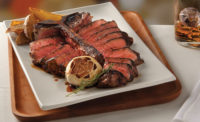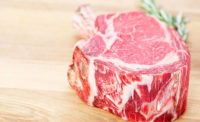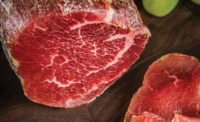The U.S. Department of Agriculture (USDA) beef grading system is based primarily on two main criteria: marbling and maturity. Marbling, flecks of fat found within the muscle of beef carcasses and evaluated by USDA graders at the 12th and 13th rib interface, helps to predict the flavor, tenderness and juiciness, or palatability. The more there is, the greater the potential for a high-quality eating experience. Marbling tends to get all of the praise and celebrity as it is a big contributor to the overall palatability of beef products; however, the lesser-known big factor in palatability is the physiological maturity of the beef carcass. And that’s where our story begins.
I’ve long talked about beef carcass maturity as being a physiological phenomenon. Maturity could be chronological or physiological. Chronological maturity is what a birthdate says how old one is. Physiological maturity is what the body says how old one is (insert high school sports injury references). Because most beef cattle in the U.S. do not show up at the packing plant with a birth certificate (this can be an exception in other countries), USDA graders assessing the potential eating qualities of beef carcasses must use physiological traits to determine how “old” the animal was at the time of harvest. Additionally, the beef community really doesn’t care, per se, how chronologically old an animal is at the time of harvest. What is important to meat quality is how physiologically old the animal is. As animals mature physically, the meat becomes less tender.
What meat enthusiasts and scientists have observed over the years is that the older an animal gets, the less tender it becomes compared with its less mature contemporaries. For example, veal is more tender than beef. The meat science community has identified the primary factor that contributes to this change in meat tenderness as animals mature: It’s the connective tissue at the muscle level that becomes more heat stable as the animal matures. At the molecular level, there becomes a stronger “lattice,” or structure, of connective tissue (collagen, which is the chewy stuff) that is more stable when cooked. Therefore, when marbling is held constant, muscle tenderness will be less desirable on meat from cattle advanced in maturity compared with those that are younger physiologically. So, what does this mean for your business?
As beef (and other species, for that matter) physiologically age, they can become less tender. How do they age physiologically? This can be a result of a multitude of things from traveling long distances for grazing or withstanding harsher climates growing up, to genetic makeup and predisposition, to growth-promoting technologies. Regardless, an animal more physiologically mature can potentially produce meat that is less tender due the connective tissue being less susceptible to heat breakdown. This means your customer, if sold meat from an animal more physiologically advanced in age, could encounter a less-than-desirable tenderness experience from that piece of meat. The beef community is aware of this and does not allow animals with advanced maturity to be considered for the USDA Prime, Choice and Select grades. These physiological determinations have in the past been evaluated by looking at the level of ossification (bone development) in the cartilaginous tissues found on the tips of the vertebrae as well as the darkness and texture of the lean in the ribeye. As cattle mature, the tips of the vertebrae change from cartilage to bone and degrees of this change help explain the physiological maturity of the animal. At the same time, as animals mature physiologically, the lean color (redness of the ribeye muscle) will be darker and have a less-firm texture.
As an alternative to evaluating physiological maturity in beef carcasses via the vertebrae and ribeye lean color, USDA has begun to allow for dentition of the cattle (evaluated at the time of harvest) to dictate the approximate age of the animal. As with people, cattle lose their baby teeth at certain life intervals which can somewhat be predicted by age. Recent research from Colorado State University and the University of Idaho have observed insignificant differences between cattle assessed as “youthful” by dentition but classified as A, B or C maturity (A is youngest maturity level, C is more advanced) by skeletal and lean maturity evaluation. This has allowed for a more accurate evaluation of beef carcasses for palatability quality and therefore a better value assessment that subsequently improves profitability for the processor and cattlemen. Yay, science!
Ultimately, we in the meat community are here to serve our customer, and it is imperative that we understand the value of the determining factors related to meat quality. Research in the past has shown there is a customer for every beef product. But more recent National Beef Quality Audit data suggest movement and pull-through demand for higher-quality beef than in the past, which also means that tenderness as it relates to physiological maturity is important to consider. We know in the meat science community that a great meat-eating experience is not determined by a single factor, but rather an amalgamation of contributing influencers. Although some variables are more front and center than others, all are vital and the systematic approach to evaluating our meat products for quality is necessary to keep that hungry customer coming back for more. NP





Report Abusive Comment